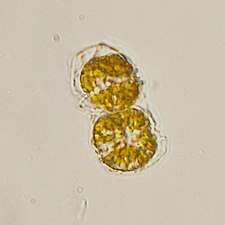Alexandrium catenella
Alexandrium catenella is a species of dinoflagellates.[1] It is among the group of Alexandrium species that produce toxins that cause paralytic shellfish poisoning, and is a cause of red tide.[2] These organisms have been found in the west coast of North America, Japan, Australia, and parts of South Africa.
| Alexandrium catenella | |
|---|---|
 | |
| Scientific classification | |
| Domain: | |
| (unranked): | |
| (unranked): | |
| Phylum: | |
| Class: | |
| Order: | |
| Suborder: | Gonyaulacaceae |
| Genus: | Alexandrium |
| Species: | A. catenella |
| Binomial name | |
| Alexandrium catenella | |
Alexandrium catenella can occur in single cells (similar to A. fundyense), but more often they are seen in short chains of 2, 4, or 8 cells. The organism is typically 20–25 µm in length and 25–32 µm in width. The cells are compressed both in the anterior and posterior ends of this specimen. Alexandrium has two flagella that enable it to swim. While one flagellum encircles the cell causing the cell the rotate and move forward, the other extends behind the cell and controls the direction. In some instances, these organisms can appear like small trains moving in the water under a microscope.
The dinoflagellate produces saxitoxin, which is a highly potent neurotoxin. If consumed, this toxin can cause paralytic shellfish poisoning (PSP).[3] By ingesting saxitoxin, humans can suffer from numbness, ataxia, incoherence, and in extreme cases respiratory paralysis and death. The toxin was discovered in 1927 in central California. Shellfish poisoning affected over a hundred humans, and now saxitoxin is recognized as one of the most deadly algal toxins.
These algal blooms have caused severe disruptions in the fisheries of these waters, and have caused filter-feeding shellfish in affected waters to become poisonous for human consumption. Because of this, A. catenella is categorized as a Harmful Algal Bloom (HAB) species. While in some areas the causes of HABs appears to be completely natural, in others, they appear to be a result of human activity, which is often coastal water pollution and over-fertilization.
Alexandrium catenella's multiplication is stimulated by higher ammonia and inorganic nitrogen concentrations. The optimal growth conditions for A. catenella include a cool temperature of around 17 to 23 °C, a medium to light illumination of 3500 to 4000 lux, and a high salinity of around 26 to 32 percent.
References
- "Alexandrium catenella". Olympic Region harmful algal bloom. Archived from the original on 12 March 2015. Retrieved 15 June 2013.
- "Alexandrium catenella". red-tide.org. Archived from the original on 28 February 2011. Retrieved 15 June 2013.
- "Alexandrium spp". Southern California Coastal Ocean Observing System. Retrieved 15 June 2013.
Further reading
- Adachi, Masao; Saka, Yoshihiko; Ishida, Yuzaburo (1996). "Identification of the toxic dinoflagellates Alexandrium catenella and A. tamarense (Dinophyceae) using DNA probes and whole-cell hybridization". Journal of Phycology. 32 (6): 1049–1052. doi:10.1111/j.0022-3646.1996.01049.x.
- Mackenzie, Lincoln (Oct 2014). "Grazing on a toxic Alexandrium catenella bloom by the lobster krill Munida gregaria (Decapoda: Galatheoidea: Munididae)". Harmful Algae. 39: 161–164. doi:10.1016/j.hal.2014.07.011.
- Diaz, Patricio A.; Molinet, Carlos; Seguel, Miriam; Diaz, Manuel; Labra, Gissela; Figueroa, Rosa I. (December 2014). "Coupling planktonic and benthic shifts during a bloom of Alexandrium catenella in southern Chile: Implications for bloom dynamics and recurrence". Harmful Algae. 40: 9–22. doi:10.1016/j.hal.2014.10.001.
- Yong, Zhang; Shu-Fei, Zhang; Lin, Lin (6 August 2012). "Comparative Transcriptome Analysis of a Toxin-Producing Dinoflagellate Alexandrium catenella and Its Non-Toxic Mutant". Marine Drugs. 12 (11): 5698–5718. doi:10.3390/md12115698. PMC 4245552.